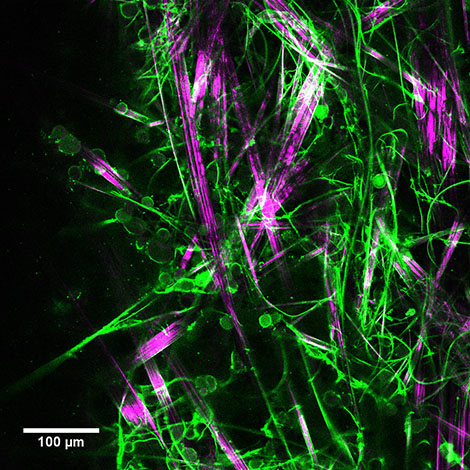Global S&T Development Trend Analysis Platform of Resources and Environment
| A new gelling molecule for growing neurons in 3D | |
| admin | |
| 2018-05-14 | |
| 发布年 | 2018 |
| 语种 | 英语 |
| 国家 | 法国 |
| 领域 | 地球科学 |
| 正文(英文) | A multidisciplinary team of researchers from CNRS, INSERM and Université Toulouse III Paul Sabatier has developed a hydrogel that can grow, develop and differentiate neural stem cells. This biomaterial could provide new paths for the development of in vitro cellular models of brain tissue or of in vivo tissue reconstruction. This work is published in ACS Applied Materials & Interfaces on May 14, 2018.Although we know how to culture cells on a two-dimensional surface, that is not representative of the actual cell environment in a live organism. In brain tissue, cells are organized and interact in three dimensions in a soft structure. The researchers' main goal was to imitate this tissue as closely as possible. They developed a hydrogel that meets suitable criteria for permeability, rigidity and biocompatibility; on that, they cultured human neural stem cells1. N-heptyl-galactonamide is a new molecule synthesized by these scientists, which is part of a family of gelling agents that usually produces unstable gels. It is biocompatible, has a very simple structure, and can be made quickly, so has many advantages. By working on the parameters for forming the gel, the researchers at the Laboratoire Interactions Moléculaires et Réactivité Chimique et Photochimique (CNRS/Université Toulouse III-Paul Sabatier), Toulouse Neuro Imaging Center (INSERM/Université Toulouse III-Paul Sabatier) and the CNRS Laboratoire d'Analyse et d'Architecture des Systèmes obtained a stable hydrogel with very low density and very low rigidity. Because of that, neural stem cells can penetrate and develop in three dimensions in the hydrogel. It also has a network composed of different types of fibers, some straight and rigid, others curved and flexible. This diversity allows neurons to develop a network of short- and long-distance connections like those in brain tissue. This new biomaterial could therefore lead to the development of three-dimensional brain tissue models that function in a manner approaching in vivo conditions. In the long run, it could be used to evaluate the effect of a medicine or to enable cells to be transplanted with their matrix to repair brain damage.  © Anaïs Chalard (IMRCP) Laurence Vaysse (ToNIC) Brice Ronsin and Stéphanie Bosch (CBI-LITC-TRI), Toulouse Cells nested in the fibers of the N-heptyl-galactonamide molecular gel. The cells are round and green. Straight, rigid fibers are pink. Curved, flexible fibers are green. Notes:1 Neural stem cells came from patient biopsies (CHU Toulouse Pôle Neurosciences). These cells are capable of differentiating into neurons and glial cells, the main types of cells in brain tissue. Bibliography:Simple synthetic molecular hydrogels from self-assembling alkylgalactonamides as scaffold for 3D neuronal cell growth, Anaïs Chalard, Laurence Vaysse, Pierre Joseph, Laurent Malaquin, Sandrine Souleille, Barbara Lonetti, Jean-Christophe Sol, Isabelle Loubinoux, Juliette Fitremann, ACS Applied Materials & Interfaces, 2018, View web site Contacts: CNRS Researcher l Juliette Fitremann l T +33 (0)5 61 55 68 04 l fitremann@chimie.ups-tlse.fr |
| URL | 查看原文 |
| 来源平台 | Centre national de la recherche scientifique |
| 文献类型 | 新闻 |
| 条目标识符 | http://119.78.100.173/C666/handle/2XK7JSWQ/106999 |
| 专题 | 地球科学 |
| 推荐引用方式 GB/T 7714 | admin. A new gelling molecule for growing neurons in 3D. 2018. |
| 条目包含的文件 | 条目无相关文件。 | |||||
| 个性服务 |
| 推荐该条目 |
| 保存到收藏夹 |
| 查看访问统计 |
| 导出为Endnote文件 |
| 谷歌学术 |
| 谷歌学术中相似的文章 |
| [admin]的文章 |
| 百度学术 |
| 百度学术中相似的文章 |
| [admin]的文章 |
| 必应学术 |
| 必应学术中相似的文章 |
| [admin]的文章 |
| 相关权益政策 |
| 暂无数据 |
| 收藏/分享 |
除非特别说明,本系统中所有内容都受版权保护,并保留所有权利。
修改评论